October half term, understandably, tends to be awash with promotions around Hallowe’en, and many historical buildings, stately homes and the like put on events to pull in the little ones. Where hotels are concerned, it can sometimes be a token experience, with little to associate with anything ghoulish – unless, of course, there’s a haunted element which, unsurprisingly, often isn’t promoted. But there is one that can genuinely lay claim to the macabre. And, indeed, proves both an unusual and delightful experience in equal measure.
The former jail in Bodmin wouldn’t be one’s first thought when considering a luxury hotel stay – indeed, the words ‘luxury’ and ‘jail’ make for the definitive oxymoron – but this has done it.
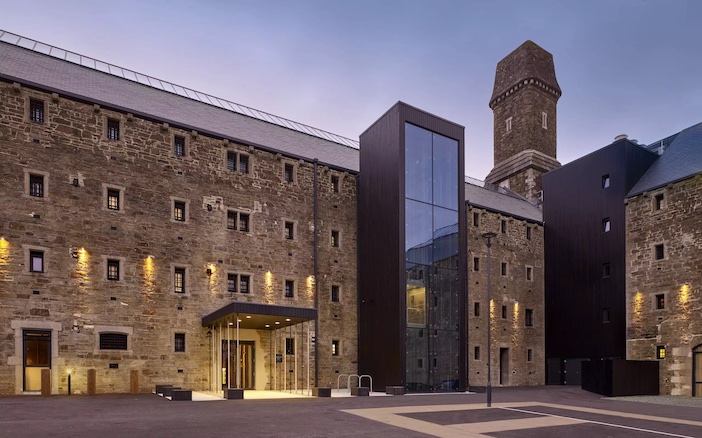
A landmark in the Cornish town from its inception in 1779 until it was decommissioned in 1927, Bodmin jail thence lived various other lives, including a nightclub in the ‘80s, until it was abandoned and left derelict in the noughties.
That state was how Tudor Hotels came across it in 2016 and struck upon the idea of turning it into a hotel. £65million and five years later, it opened its doors once more. As odd as it might be to say it, its new incarnation has remained sympathetic to its former self. As much of the authenticity has been retained, tastefully, to maintain the experience, but thankfully not giving way to novelty. They could have gutted the building and turned it into a contemporary eyesore, but the notion of staying in Bodmin jail is, well, to spend the night in a jail.
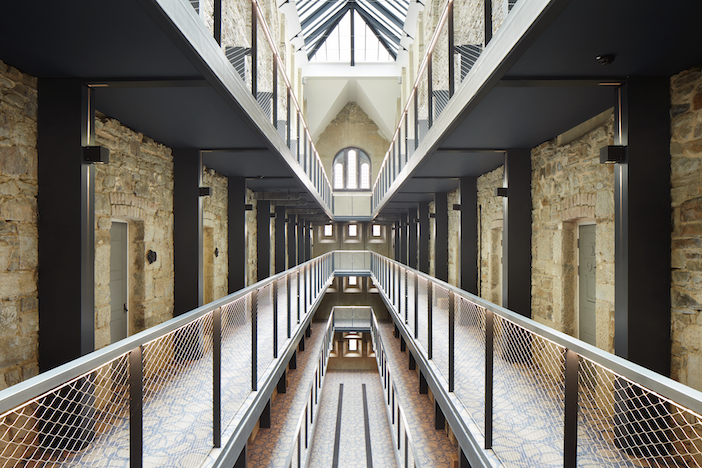
Walking in, the prison experience is unmistakeable; the mezzanine gangways remain (albeit nicely carpeted), the roof is now a glass atrium, many of the cells’ original doors feature and some of the ironwork has been integrated (cell nameplates are a nice touch). And there are points of historical interest, too, notably the ‘condemned cell’, where those sentenced to death were kept separate, is now an exhibition space showing photos of the dilapidated building and its past uses.
Rooms are billed as luxury “cells” and the fabric of each remain – the coarse exposed stonework and barred windows – but rather better appointed than for past inmates. Principally, for each room three cells have been knocked together, so you get an impression of how big they originally were; the bed taking up a substantial part of a single cell. Then, with sofa, settle, TV, complimentary mini bar and a beautifully appointed bathroom, a three-night stretch here would feel like easy time, if you’ll forgive the expression. A particularly nice touch is the plaque attributed to a previous occupant, pointed out by our little nest of vipers, grounding our stay in the building’s history. Ours, one James Cook, spent time here for forging coins before being transported to Australia in 1838.
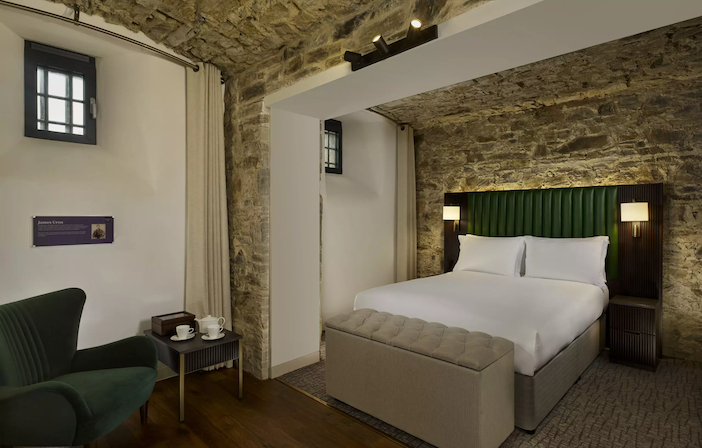
Clearly proud of this heritage, it rightly showcases its offering with a newspaper of sorts delivered to rooms, as a Guest Guide, featuring titbits of its history, including introducing ‘stir about’, a lumpier version of gruel made from cornmeal and water. Thankfully, the catering has come up a notch since those heady days and the Chapel now makes up the hotel’s restaurant of the same name. Between tall gothic arched windows are what look like pulpits, beautifully uplit and adorned with flora. During dinner, the lights are dimmed and a rippling light projection on the back wall adds an atmospheric, albeit curious, touch – but prove little distraction to the talents of Head Chef, Dane Watkins.
Beetroot burrata with peas is an excellent take on a classic, but it’s the crab roulade with apple and gazpacho that wins us over. And while our little one’s pizza, the circumference of a car tyre, keeps her more than occupied, we tuck into mains befitting our Cornish stay. Cod loin with caper polenta and pea velouté makes for a highbrow fish and chips, and rolled, stuffed plaice is given a sweet touch with an artichoke purée that shows that this is not just token cooking in an eye-catching setting.
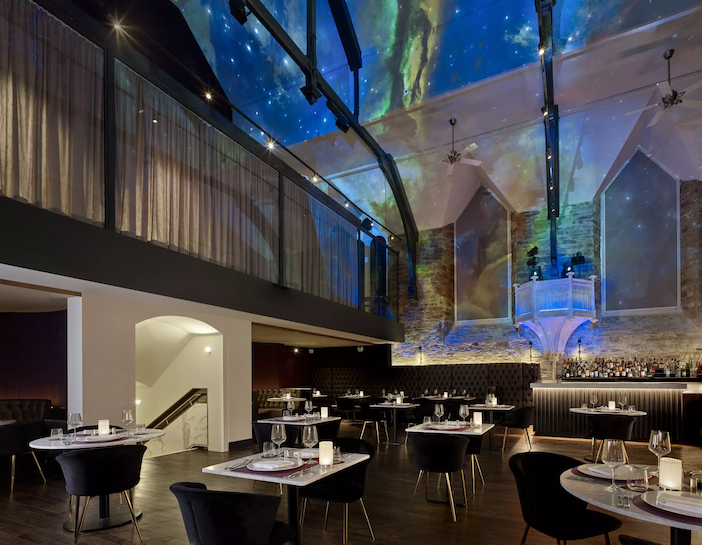
For all the references to its past, what’s most telling about staying here comes the next morning. As I pull back the curtains, a narrow shaft of light comes though the cell window, just catching the edges of the stonework and showing the contrast in the room. Experiencing what it must have been like in its original form is a sobering thought, and something that will be given more embellishment with what we have next in store.
Following a breakfast far better than stir-up – shakshuka and the obligatory ‘full Cornish’ are nice touches – further insights about life in Bodmin Jail follow on the Heritage Tour in the museum. It’s a fascinating insight, through sets featuring holographs and ‘4D’ elements, with animated anecdotes from our guide, Tom, as we follow the crimes, trial and sentencing of three historical figures, before we’re ushered into the remaining original cells in the basement for details of prison life and conditions through the centuries.
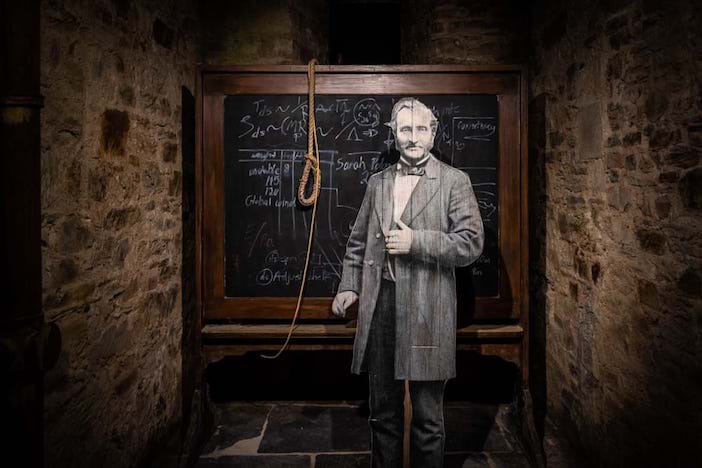
Perhaps most notable is that the execution room has been preserved, complete with noose and ‘long drop’ trapdoor, and a somewhat macabre ‘interactive’ finale – no plot spoilers – to round off the experience. A board on the wall lists those executed, and their crimes, over the centuries. Knowing what slight misdemeanour some inmates committed to be incarcerated, even executed for, certainly puts things into perspective.
Unlike former inmates, with the benefit of freedom and Cornwall at our disposal, we consider where we might venture outside the prison walls. Bodmin – and the jail – is ideally situated at a junction of the Camel Trail, the cycle path that runs alongside the river Camel. Flat and leisurely going it might be, but still makes for a cake-earning 12 miles and back to Wendfordbridge, so the ‘After Dark’ afternoon tea back at the hotel is a welcome reward. Naturally, there’s a certain ghoulish theme with coffin-shaped brownies and skull-topped pistachio cake, but the highlight, of course, are the crumbly scones, served warm, with thick clotted cream and strawberry jam; the classic Cornish cream tea.
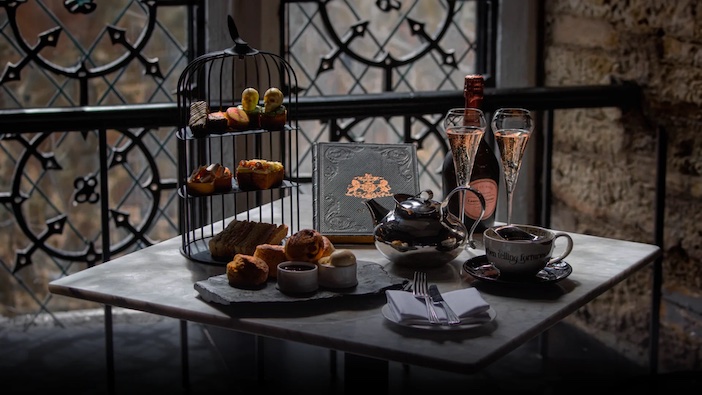
Further afield, the advantage of Bodmin is that it is equally placed between north and south coasts, so one isn’t held to either. Venturing north offers Padstow and Rock, Tintagel or Port Isaac, but we opt to go south, considering Polperro and Charlestown, but settle on Fowey, that eminently charming home of Agatha Christie, herself no stranger to writing about crimes and misdemeanours.
When it comes to hotels, there are those that are novelties (Vegas, anyone?), those that are ‘themed’, even those that are gimmicky, but where that’s often just a superficial spin, the offering then fails. The beauty – and I don’t use the word lightly – of Bodmin Jail is that it sees itself as a hotel first, it just happens to be in a really rather one-off setting.
Cells – ahem, rooms – at Bodmin Jail Hotel start from £179 per night. For more information, including details of interactive tours and experiences, and for what’s on offer for Halloween, such as a Ghost Walk and Murder Mystery dinner, please visit www.bodminjailhotel.com.




